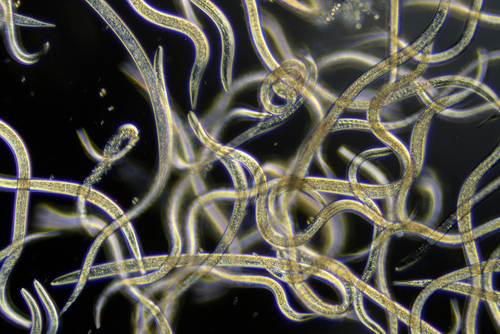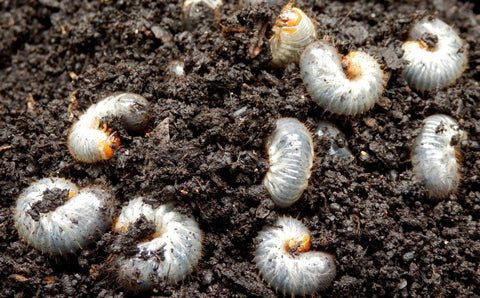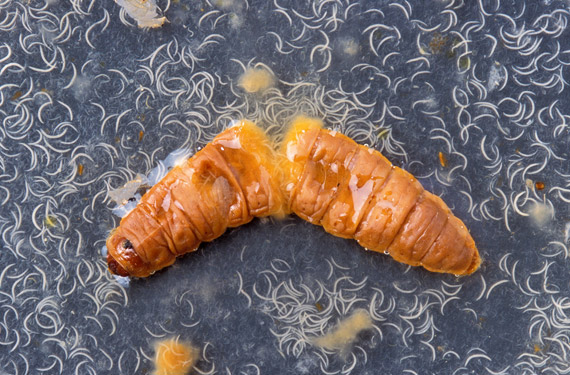Eating a meal with just a knife is less successful than using a knife and fork. Often when we are dealing with pest management, we want to use all the tools available to us in order to gain a better result.
Due to the hard work of Syngenta, we now have a fully licensed, effective, and safe insecticide to help control chafer grubs and leather jackets. However, the timing of the use of the product, and the age of the grub are critical factors in the effectiveness of the treatment. Luckily, we have in our armoury a biological control that can help in our management of these destructive lawn pests.
 What are nematodes?
What are nematodes?
These microscopic worms are among the most abundant creatures on earth. There is estimated to be around 20,000 named species of nematodes and they can be found in a variety of places including soil. Some nematodes may be considered a nuisance and might live as parasites in animals or attack plant roots. However, many nematode species can be used beneficially to help control pests.
How are nematodes used in the control of lawn pests?
Certain species of nematodes actively seek out grubs which they use as a food source and for reproduction. Introducing these nematodes, in sufficient quantity, into soil has been proven to significantly reduce the population of chafer grubs and leather jackets. Once in the soil, the nematodes pick up on pheromones or carbon dioxide produced by the grubs. Some nematodes are classed as ‘cruisers’ and move through the soil to find their target grub. Others are ‘ambushers’ and wait for the grubs to pass their way. Once the nematodes come into contact with the grub, they will enter it through a natural opening. When inside, the nematode produces bacteria which begins to rot the grub from the inside, providing a food source and a place for nematodes to reproduce. When the food source is exhausted the nematodes move from the dead grub and the process is repeated until the population of grubs falls so low that the nematodes begin to die off through starvation.
The challenges of using nematodes as a biological control
Nematodes are alive, they need to remain alive and active in the soil to be effective. The greater the population of nematodes within the soil, the more effective they are at controlling the lawn pest. Here we have a number of issues. Firstly, enough nematodes need to reach the grubs quickly, before they starve, so the quantity applied, and the application method and timing is critical. The application rate is between 2.5 and 5 billion nematodes per 10,000 square meters. That equates to around 25 and 50 per square centimetre of soil.
Nematodes arrive from the manufacturer refrigerated to slow down their metabolism. To use the nematodes, they must be mixed with water and applied onto the area in question. Nematodes are applied with a sprayer. The sprayer often has filters to prevent nozzle blockages. The sprayer uses pressurised water. The pressure of the water forcing nematodes through filters can kill them. So, the correct filter size and water pressure is critical. Once mixed with water they will quickly die, so there needs to be no delay in application. Water is essential however, as the microscopic worms will travel through water to mobilise themselves in the soil profile. Therefore, the soil must be damp to allow the nematodes into the soil and to move through the soil to find their host – the destructive lawn grubs. That’s not all, nematodes are killed by UV light. If they remain on the surface of the soil or stuck to grass leaf for too long their population will decrease. Fewer nematodes in the soil means less-effective results.
Failure to store the nematodes correctly following delivery and before use will reduce the number of live nematodes in the application. Failure to apply the nematodes to damp soil or to water the soil after application will greatly reduce their numbers. Failure to select the correct species of nematode for the target pest will result in no pest death. Failure to apply to soil that is warm enough for the pest and the nematodes to be active will render them ineffective. And one final potential point of failure, failure to apply to apply nematodes at the correct stage of grub life will mean that the grubs are able to defend themselves against any nematodes that enter their body and therefore they will not be killed by the bacteria produced.
As you can tell, the use of biological control of lawn pests is complex and it is critical that the correct procedures are followed to gain the correct results. Nematodes do not last long within the soil and therefore should be applied professionally and regularly as an effective, preventative approach to lawn pest management.
Used alone, nematodes have been proven to provide around a 60% control of leather jackets. Grub X alone will provide around 80% control. The combination of both of these treatments will provide around 95% grub control.
Find out more about our services that control leather jackets and chafer grubs here > Lawn Grub Control Services in Hampshire and Sussex

 Established 2016
Established 2016



